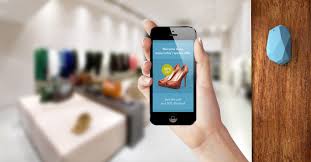
An Estimote Beacon in a retail setting.
Beacons are hot right now, especially in the mobile and retail spaces. But… what IS a beacon you may ask. Well, The easiest answer is that beacons are sort of like an indoor GPS and alert tool. With the right app installed on your smartphone, beacons talk to the app to pinpoint your location (even down to a few feet) and push content, communications or alerts your way. Beacons are installed in a growing number of retail establishments now, and the potential for use at live events — from stadiums to board rooms — is exciting.
We asked a few #eventprofs to share their thoughts on this up-and-coming technology. Click on the title tabs to see what each expert has to say!

Glen Bentley, VP, Product Management, Certain
We are very excited about beacon technology, and how this will be leveraged to further enhance the attendee experience at an event. Much like museums are starting to utilize beacons to automatically provide information about a specific exhibit or piece of art based on where a visitor is within the museum, beacons at an event can provide attendees with relevant information based on the exhibitors booth they are visiting or conference session they are attending. This provides the ability to automatically push relevant content to the attendee, while also serving to provide a more engaging attendee experience.
Beacon technology is moving very quickly, but is certainly starting to become more mainstream in a variety of different venues. With that said, although there will be challenges as the technology continues to evolve, the more significant challenge will be related to privacy concerns Tracking an attendee’s behavior and providing attendees with more targeted and relevant information is certainly very compelling, however, it must be done while also respecting an attendees privacy. Ensuring that attendees privacy concerns are respected and addressed will be critical as the use of beacon technology continues to take hold at events.

Robin Jones, CMO, QuickMobile
There is real potential that BLE/Beacon technology could take the attendee experience at events to a new level. The ability to automatically pick up a signals when mobile users are in proximity and initiate communication either device to device or environment to device opens up a number of exciting opportunities. Meeting organizers will also gain benefits of this new data source that can provide additional insights into how attendees interact within the event environment whether it be an understanding of where attendees spend their time, how much time they spend in different areas, as well as an understanding of how they move throughout the physical space.
Like any new technology, there will be obstacles to overcome prior to vendors successfully delivering truly optimized, valuable end user experiences. There are currently known issues with regards to mobile coverage, reliability and performance as beacon suppliers continue to evolve their products and services based on feedback from early real world executions. Also, as with any push-like technology, there are concerns both around individual privacy and the potential of having users bombarded with messages and notifications in an increasingly noisy mobile experience.
Events of any size could benefit from leveraging beacon technologies, although the true test is ensuring that the experience is non-disruptive and ultimately adds real value to the attendees experience.
Once you understand where and when attendees are within the event, there are a number of potential applications that open up to help drive networking, enhance engagement, track attendance and personalize content. As an example, within a keynote session attendees could be seamlessly checked-in through the beacon technology as they walk into the room. Imagine the possibilities that now open up through the mobile application to engage the attendees in a more personalized and interactive experience with information being provided based upon their role, interests or preferences. This could be in the form of videos or documents or messaging that support the keynote theme along with audience segmented interactive polls, Q&A or even team activities that drive further engagement and ultimately insights into the overall attendee experience.
There are also a number of other potential applications:
- help drive peer to peer connections and networking opportunities
- enhancing engagement activities, such as gamification
- track attendee attendance and check-in
- pushing targeted content, promotions, etc.
Yes. We are actively working with a number of Beacon vendors and key customers to identify opportunities so we can better understand how to effectively layer this functionality on to the existing mobile experience.
Connect with Robin on Twitter.

Steve Mackenzie, VP, Global Channel, etouches
Connect with Steve on Twitter.

Eric Olson, CEO, Zerista
While location-aware technology is a big breakthrough for live events, it creates as many questions as it does answers. When event producers are planning to use beacons at events, their are two key things to consider: First, and most importantly, they need to protect their users’ personal data. There have been events where beacons have been hacked and user data compromised. Make sure you’re asking questions about the security mechanisms that protect the beacons themselves from abuse. Not all beacons are created equal. Second, these experiences need to be carefully planned to increase the value of the event itself, and event producers should be cautious not to “spam” their audience as it could lead to negative backlash and reduced usage of the technologies they’re trying to promote.
The event producers that seem most excited about it are events where collaboration or content marketing are important. When collaboration is important, beacon technology can be used to draw users into interactive features or to help users find the right people to collaborate with. When content marketing is important, beacons can be used to get the great content in the hands of the most valuable sales prospects — and provide measurement on the impact of that content that doesn’t exist today at events.
One more example… When beacons are used on the expo floor, they can be used to create connections between prospects and content from exhibitors. So, when an attendee walks into the booth of a key sponsor, the app gently presents an opportunity to view, save or share a new whitepaper from that sponsor. If the prospect downloads it or share it, the sponsor has put its content to work and created a new datapoint about a prospects interest whether that person is scanned in the booth or not. In this function, beacons start to carry content marketing into the events space in a more meaningful and measurable way.
The key to success here will be testing. We’re working with our clients to test one or two value-add experiences at a time. We start by crafting a user story that we think is important to the event, which looks like this: As a (USER TYPE), I want to (GOAL) because (BENEFIT). So, for one of our clients who focuses on driving innovation through events that bring together Fortune 100 C-Level executives created this user story: “As an ATTENDEE, I want to DO ONLINE COLLABORATION WITH OTHER ATTENDEES because IT ALLOWS US TO CREATE AND DOCUMENT BETTER, MORE ACTIONABLE IDEAS FROM THE CONTENT BEING PRESENTED.” And we’re working on using beacons to serve up this discussion in real-time to the people who are in the workshop.
Connect with Eric on Twitter.

Jay Tokosch, CEO, Core-Apps
iBeacon can really be a game changer for the event industry. With both Apple and Android adopting the technology, you have two major platforms, which the majority of smartphones users are on using the technology for location services. The technology is relatively fast, easy to deploy, and inexpensive once you know how to set it up. It can provide users’ locations at an event. and there are so many things that can be done with that knowledge to help users and organizers for their event.
Android has many versions based on the phone manufacturer and not all of the versions have the iBeacon tech in them or are fully functioning. So that leaves out some users today. But it will eventually be in all versions. Setup is still a little complicated but will get easier as we learn more. The cost of the devices will also come down as they are used more.
I can see this being used for trade shows especially but also conferences as well for many reasons. Helping guide people around and determining traffic flow will be the first such features as well as check-ins for location.
We have used this to determine users location providing event traffic analytics. We have also used this to setup a game at CES to drive traffic to underserved areas on the show floor. The game was quite fun and was really a new way to achieve the organizers’ goals.
Having worked with the technology for almost a year, there is still a lot to learn about this technology as it evolves. We are only scratching the surface now with floor analytics and games. We have many other features and offerings planned with this technology as it grows.
Connect with Jay on Twitter.
The Meeting Pool
Latest posts by The Meeting Pool (see all)
- PRESS RELEASE: Europalco presents at IMEX its solutions for events and shows - June 1, 2022
- PRESS RELEASE: EUROPALCO launches a new format of hybrid events and turns distance into an advantage - May 19, 2022
- PRESS RELEASE: EUROPALCO Turns 25 and Consolidates Portugal as a Privileged Destination - March 25, 2022

